Review of Asymmetric Seafloor Spreading and Oceanic Ridge Jumps in the South China Sea
Abstract
1. Introduction
2. Asymmetric Seafloor Spreading and Ridge Jumps
3. Asymmetric Seafloor Spreading and Ridge Jumps in the South China Sea
4. Conclusions and Future Prospects
Author Contributions
Funding
Institutional Review Board Statement
Informed Consent Statement
Data Availability Statement
Acknowledgments
Conflicts of Interest
References
- Savva, D.; Pubellier, M.; Franke, D.; Chamot-Rooke, N.; Meresse, F.; Steuer, S.; Auxietre, J.-L. Different expressions of rifting on the South China Sea margins. Mar. Pet. Geol. 2014, 58, 579–598. [Google Scholar] [CrossRef]
- Wang, P.; Li, S.; Suo, Y.; Guo, L.; Santosh, M.; Li, X.; Wang, G.; Jiang, Z.; Liu, B.; Zhou, J. Structural and kinematic analysis of Cenozoic rift basins in South China Sea: A synthesis. Earth-Sci. Rev. 2021, 216, 103522. [Google Scholar] [CrossRef]
- Villeneuve, M.; Martini, R.; Bellon, H.; Réhault, J.-P.; Cornée, J.-J.; Bellier, O.; Burhannuddin, S.; Hinschberger, F.; Honthaas, C.; Monnier, C. Deciphering of six blocks of Gondwanan origin within Eastern Indonesia (South East Asia). Gondwana Res. 2010, 18, 420–437. [Google Scholar] [CrossRef][Green Version]
- Wang, P.; Huang, C.-Y.; Lin, J.; Jian, Z.; Sun, Z.; Zhao, M. The South China Sea is not a mini-Atlantic: Plate-edge rifting vs intra-plate rifting. Natl. Sci. Rev. 2019, 6, 902–913. [Google Scholar] [CrossRef] [PubMed]
- Wang, P. Exploring the deep sea processes in the South China Sea. Sci. Technol. Rev. 2020, 38, 6–20. [Google Scholar] [CrossRef]
- Lin, J.; Sun, Z.; Li, J.; Zhou, Z.; Zhang, F.; Luo, Y. South China Seabasin opening: Lithospheric rifting and interactionwith surroundingsubduction zones. Sci. Technol. Rev. 2020, 38, 35–39. [Google Scholar] [CrossRef]
- Wang, P.; Li, S.; Suo, Y.; Guo, L.; Wang, G.; Hui, G.; Santosh, M.; Somerville, I.D.; Cao, X.; Li, Y. Plate tectonic control on the formation and tectonic migration of Cenozoic basins in northern margin of the South China Sea. Geosci. Front. 2020, 11, 1231–1251. [Google Scholar] [CrossRef]
- Dick, H.J.B.; Lin, J.; Schouten, H. An ultraslow-spreading class of ocean ridge. Nature 2003, 426, 405–412. [Google Scholar] [CrossRef] [PubMed]
- Macdonald, K.C. Mid-ocean ridges: Fine scale tectonic, volcanic and hydrothermal processes within the plate boundary zone. Annu. Rev. Earth Planet. Sci. 1982, 10, 155. [Google Scholar] [CrossRef]
- White, R.S.; Detrick, R.S.; Mutter, J.C.; Buhl, P.; Minshull, T.A.; Morris, E. New seismic images of oceanic crustal structure. Geology 1990, 18, 462–465. [Google Scholar] [CrossRef]
- Li, Y.; Niu, X.; Ruan, A.; Liu, S.; Haider, S.W.; Wei, X. On spreading rates and crustal structure at mid-ocean ridges. Chin. J. Geophys. 2020, 63, 1913–1926. [Google Scholar] [CrossRef]
- Cannat, M.; Sauter, D.; Mendel, V.; Ruellan, E.; Okino, K.; Escartin, J.; Combier, V.; Baala, M. Modes of seafloor generation at a melt-poor ultraslow-spreading ridge. Geology 2006, 34, 605–608. [Google Scholar] [CrossRef]
- Edmonds, H.; Michael, P.; Baker, E.; Connelly, D.; Snow, J.; Langmuir, C.; Dick, H.; Mühe, R.; German, C.; Graham, D. Discovery of abundant hydrothermal venting on the ultraslow-spreading Gakkel ridge in the Arctic Ocean. Nature 2003, 421, 252–256. [Google Scholar] [CrossRef] [PubMed]
- Sauter, D.; Cannat, M.; Meyzen, C.; Bezos, A.; Patriat, P.; Humler, E.; Debayle, E. Propagation of a melting anomaly along the ultraslow Southwest Indian Ridge between 46° E and 52°20′ E: Interaction with the Crozet hotspot? Geophys. J. Int. 2009, 179, 687–699. [Google Scholar] [CrossRef]
- Schroeder, T.; Cheadle, M.J.; Dick, H.J.; Faul, U.; Casey, J.F.; Kelemen, P.B. Nonvolcanic seafloor spreading and corner-flow rotation accommodated by extensional faulting at 15 N on the Mid-Atlantic Ridge: A structural synthesis of ODP Leg 209. Geochem. Geophys. Geosyst. 2007, 8, Q06015. [Google Scholar] [CrossRef]
- Ling, Z.; Gao, J.; Zhao, L.; Yang, C.; Guan, Q.; Zhang, T. The asymmetric crustal structures of basement ridges of the Gakkel Ridge. Chin. J. Geophys. 2019, 62, 1755–1771. [Google Scholar] [CrossRef]
- DeMets, C.; Gordon, R.G.; Argus, D.F. Geologically current plate motions. Geophys. J. Int. 2010, 181, 1–80. [Google Scholar] [CrossRef]
- Escartin, J.; Smith, D.K.; Cann, J.; Schouten, H.; Langmuir, C.H.; Escrig, S. Central role of detachment faults in accretion of slow-spreading oceanic lithosphere. Nature 2008, 455, 790–794. [Google Scholar] [CrossRef]
- Searle, R.C.; Bralee, A.V. Asymmetric generation of oceanic crust at the ultra-slow spreading Southwest Indian Ridge, 64° E. Geochem. Geophys. Geosyst. 2007, 8, Q05015. [Google Scholar] [CrossRef]
- Zhang, T.; Gao, J.; Wang, W.; Wu, Z.; Shen, Z.; Yang, C. Asymmetric spreading rates and crustal structures of the Mohns Ridge since 20 Ma. Chin. J. Geophys. 2018, 61, 3263–3277. [Google Scholar] [CrossRef]
- Stein, S.; Melosh, H.J.; Minster, J.B. Ridge migration and asymmetric sea-floor spreading. Earth Planet. Sci. Lett. 1977, 36, 51–62. [Google Scholar] [CrossRef]
- Müller, R.D.; Roest, W.R.; Royer, J.-Y. Asymmetric sea-floor spreading caused by ridge–plume interactions. Nature 1998, 396, 455–459. [Google Scholar] [CrossRef]
- Müller, R.D.; Sdrolias, M.; Gaina, C.; Roest, W.R. Age, spreading rates, and spreading asymmetry of the world’s ocean crust. Geochem. Geophys. Geosyst. 2008, 9, Q04006. [Google Scholar] [CrossRef]
- Cannat, M.; Rommevaux-Jestin, C.; Fujimoto, H. Melt supply variations to a magma-poor ultra-slow spreading ridge (Southwest Indian Ridge 61° to 69° E). Geochem. Geophys. Geosyst. 2003, 4, 9104. [Google Scholar] [CrossRef]
- Liang, Y.; Li, J.; Li, S.; Ni, J.; Ruan, A. The Magmato-tectonic dynamic model for the Indomed-Gallieni segment of the central southwest Indian ridge. Chin. J. Geophys. 2014, 57, 2993–3005. [Google Scholar] [CrossRef]
- Wang, D.; Li, J.; Li, Y. Rheology of the lower crust controls the polarity of conjugated basins asymmetry on the South Atlantic passive margin. Earth Sci. Front. 2020, 27, 254. [Google Scholar] [CrossRef]
- Johansen, S.E.; Panzner, M.; Mittet, R.; Amundsen, H.E.F.; Lim, A.; Vik, E.; Landrø, M.; Arntsen, B. Deep electrical imaging of the ultraslow-spreading Mohns Ridge. Nature 2019, 567, 379–383. [Google Scholar] [CrossRef] [PubMed]
- Murton, B.J.; Baker, E.T.; Sands, C.M.; German, C.R. Detection of an unusually large hydrothermal event plume above the slow-spreading Carlsberg Ridge: NW Indian Ocean. Geophys. Res. Lett. 2006, 33, L10608. [Google Scholar] [CrossRef]
- Schmidt-Aursch, M.C.; Jokat, W. 3D gravity modelling reveals off-axis crustal thickness variations along the western Gakkel Ridge (Arctic Ocean). Tectonophysics 2016, 691, 85–97. [Google Scholar] [CrossRef]
- Wang, T.; Tucholke, B.E.; Lin, J. Spatial and temporal variations in crustal production at the Mid-Atlantic Ridge, 25° N–27°30′ N and 0–27 Ma. J. Geophys. Res. Solid Earth 2015, 120, 2119–2142. [Google Scholar] [CrossRef]
- Yang, C.; Han, X.; Wang, Y.; Li, H.; Qiu, Z.; Wu, Z. Characteristics of the multibeam backscatter of Carlsberg Ridge (60°–61° E) and its indication on the tectonics and magmatism. J. Mar. Sci. 2018, 36, 37–49. [Google Scholar] [CrossRef]
- Mittelstaedt, E.; Ito, G.; van Hunen, J. Repeat ridge jumps associated with plume-ridge interaction, melt transport, and ridge migration. J. Geophys. Res. Solid Earth 2011, 116, B01102. [Google Scholar] [CrossRef]
- Brozena, J.M.; White, R.S. Ridge jumps and propagations in the South Atlantic Ocean. Nature 1990, 348, 149–152. [Google Scholar] [CrossRef]
- Bruguier, N.; Minshull, T.; Brozena, J. Morphology and tectonics of the Mid-Atlantic Ridge, 7°–12° S. J. Geophys. Res. Solid Earth 2003, 108, 2093. [Google Scholar] [CrossRef]
- Mittelstaedt, E.; Ito, G.; Behn, M.D. Mid-ocean ridge jumps associated with hotspot magmatism. Earth Planet. Sci. Lett. 2008, 266, 256–270. [Google Scholar] [CrossRef]
- Mittelstaedt, E.; Soule, S.; Harpp, K.; Fornari, D.; McKee, C.; Tivey, M.; Geist, D.; Kurz, M.D.; Sinton, C.; Mello, C. Multiple expressions of plume-ridge interaction in the Galápagos: Volcanic lineaments and ridge jumps. Geochem. Geophys. Geosyst. 2012, 13, Q05018. [Google Scholar] [CrossRef]
- Li, X.; Kind, R.; Yuan, X.; Wölbern, I.; Hanka, W. Rejuvenation of the lithosphere by the Hawaiian plume. Nature 2004, 427, 827–829. [Google Scholar] [CrossRef] [PubMed]
- Li, J.; Zhang, H.; Li, H.; Liu, Z. Mid-ocean Ridge Jump and Extension in the Context of Hotspots: Discussion on the Tectonic Evolution of Indian Ocean. Geol. J. China Univ. 2016, 22, 74. [Google Scholar]
- Artemieva, I.M.; Yang, H.; Thybo, H. Incipient ocean spreading beneath the Arabian shield. Earth-Sci. Rev. 2022, 226, 103955. [Google Scholar] [CrossRef]
- Huang, C.; Wang, P.; Yu, M.; You, C.; Liu, C.S.; Zhao, X.; Shao, L.; Zhong, G.; Yumul, G.P.J. Potential role of strike-slip faults in opening up the South China Sea. Natl. Sci. Rev. 2019, 6, 891–901. [Google Scholar] [CrossRef]
- Hall, R. Cenozoic geological and plate tectonic evolution of SE Asia and the SW Pacific: Computer-based reconstructions, model and animations. J. Asian Earth Sci. 2002, 20, 353–431. [Google Scholar] [CrossRef]
- Sibuet, J.-C.; Yeh, Y.-C.; Lee, C.-S. Geodynamics of the South China Sea. Tectonophysics 2016, 692, 98–119. [Google Scholar] [CrossRef]
- Briais, A.; Patriat, P.; Tapponnier, P. Updated interpretation of magnetic anomalies and seafloor spreading stages in the South China Sea: Implications for the Tertiary tectonics of Southeast Asia. J. Geophys. Res. Solid Earth 1993, 98, 6299–6328. [Google Scholar] [CrossRef]
- Taylor, B.; Hayes, D.E. Origin and History of the South China Sea Basin. In The Tectonic and Geologic Evolution of Southeast Asian Seas and Islands: Part 2; American Geophysical Union: Washington, DC, USA, 1983; Volume 27, pp. 23–56. [Google Scholar]
- Li, J. Dynamics of the continental margins in South China Sea: Scientific experiments and research progresses. Chin. J. Geophys. 2011, 54, 883–893. [Google Scholar] [CrossRef]
- Qin, X.; Zhang, B.; Zhao, B. Distribution characteristics of Mohorovicic discontinuity in the South China Sea Basin and suggestions for drilling preparation area. Acta Geol. Sin. 2022, 96, 2635–2646. [Google Scholar] [CrossRef]
- Qin, X.; Zhao, B.; Li, F.; Zhang, B.; Wang, H.; Zhang, R.; He, J.; Chen, X. Deep structural research of the South China Sea: Progresses and directions. China Geol. 2019, 2, 530–540. [Google Scholar] [CrossRef]
- Ren, J.; Luo, P.; Gao, Y.; Wang, H.; Lei, C.; Chao, P. Structural, sedimentary and magmatic records during continental breakup at southwest sub-basin of South China Sea. Earth Sci. 2022, 47, 2287–2302. [Google Scholar] [CrossRef]
- Lei, C.; Alves, T.M.; Ren, J.; Pang, X.; Yang, L.; Liu, J. Depositional architecture and structural evolution of a region immediately inboard of the locus of continental breakup (Liwan Sub-basin, South China Sea). GSA Bull. 2019, 131, 1059–1074. [Google Scholar] [CrossRef]
- Fan, Q.; Li, J.; Liu, C.; Pan, X. In Fluenceover Migration of MOR Spreading Center from Detachment Faults of Mid-Ocean Ridges and Development of Oceanic Core Complex. Acta Geol. Sin. 2018, 92, 2040–2050. [Google Scholar]
- Li, H.; Zheng, J.; Pang, X.; Ren, J.; Li, R. Structural Patterns and Controlling Factors of Differential Detachment in the Northern Continental Margin of the South China Sea: Taking Baiyun-Liwan Deep Water Area in the Pearl River Mouth Basin as an Example. China Offshore Oil Gas 2020, 32, 24–35. [Google Scholar] [CrossRef]
- Ren, J.; Pang, X.; Yu, P.; Lei, C.; Luo, P. Characteristics and formation mechanism of deepwater and ultra-deepwater basins in the northern continental margin of the South China Sea. Chin. J. Geophys. 2018, 61, 4901–4920. [Google Scholar] [CrossRef]
- Ren, J.; Pang, X.; Lei, C.; Yuan, L.; Liu, J.; Yang, L. Ocean and continent transition in passive continental margins and analysis of lithospheric extension and breakup process: Implication for research of the deepwater basins in the continental margins of South China Sea. Earth Sci. Front. 2015, 22, 102. [Google Scholar] [CrossRef]
- Wang, P. Tracing the life history of a marginal sea—On “The South China Sea Deep” research program. Chin. Sci. Bull. 2012, 57, 3093–3114. [Google Scholar] [CrossRef]
- Yao, B.; Zeng, W.; Hayes, D.E. The Geological Menoir of South China Sea Surveyed Jointly by China and USA; China University of Geosciences Press: Wuhan, China, 1994. [Google Scholar]
- Li, C.-F.; Xu, X.; Lin, J.; Sun, Z.; Zhu, J.; Yao, Y.; Zhao, X.; Liu, Q.; Kulhanek, D.K.; Wang, J.; et al. Ages and magnetic structures of the South China Sea constrained by deep tow magnetic surveys and IODP Expedition 349. Geochem. Geophys. Geosyst. 2014, 15, 4958–4983. [Google Scholar] [CrossRef]
- Ben-Avraham, Z.; Uyeda, S. The evolution of the China Basin and the mesozoic paleogeography of Borneo. Earth Planet. Sci. Lett. 1973, 18, 365–376. [Google Scholar] [CrossRef]
- Taylor, B.; Hayes, D.E. The Tectonic Evolution of the South China Basin. In The Tectonic and Geologic Evolution of Southeast Asian Seas and Islands: Part 1; American Geophysical Union: Washington, DC, USA, 1980; Volume 23, pp. 89–104. [Google Scholar]
- Li, C.F.; Li, J.; Ding, W.; Franke, D.; Yao, Y.; Shi, H.; Pang, X.; Cao, Y.; Lin, J.; Kulhanek, D.K. Seismic stratigraphy of the central South China Sea basin and implications for neotectonics. J. Geophys. Res. Solid Earth 2015, 120, 1377–1399. [Google Scholar] [CrossRef]
- Barckhausen, U.; Roeser, H.A. Seafloor spreading anomalies in the South China Sea revisited. Cont. -Ocean Interact. Within East Asian Marg. Seas 2004, 149, 121–125. [Google Scholar] [CrossRef]
- Barckhausen, U.; Engels, M.; Franke, D.; Ladage, S.; Pubellier, M. Evolution of the South China Sea: Revised ages for breakup and seafloor spreading. Mar. Pet. Geol. 2014, 58, 599–611. [Google Scholar] [CrossRef]
- Lin, J.; Li, J.; Xu, Y.; Sun, Z.; Xia, S.; Huang, X.; Xie, X.; Li, C.; Ding, W.; Zhou, Z.; et al. Ocean drilling and major advances in marine geological and geophysical research of the South China Sea. Acta Oceanol. Sin. 2019, 41, 125–140. [Google Scholar] [CrossRef]
- Li, J.; Ding, W.; Gao, J.; Wu, Z.; Zhang, J. Cenozoic evolution model of the sea-floor spreading in South China Sea: New constraints from high resolution geophysical data. Chin. J. Geophys. 2011, 54, 894–906. [Google Scholar] [CrossRef]
- Li, J.; Ding, W.; Wu, Z.; Zhang, J.; Dong, C. The propagation of seafloor spreading in the southwestern subbasin, South China Sea. Chin. Sci. Bull. 2012, 57, 3182–3191. [Google Scholar] [CrossRef]
- Li, C.; Li, Z.; Li, Y.; Liu, Y.; Peng, X.; Wen, Y. Large Geological Differences between the East and Southwest Subbasins of the South China Sea. Sci. Technol. Rev. 2020, 38, 40–45. [Google Scholar] [CrossRef]
- Ren, J.; Lei, C. Tectonic stratigraphic framework of Yinggehai-Qiongdongnan Basins and its implication for tectonic province division in South China Sea. Chin. J. Geophys. 2011, 54, 3303–3314. [Google Scholar] [CrossRef]
- Wang, W.; Yao, Y.; Cai, Z.; Yin, Z.; Zhu, R.; Wei, J.; Ju, D. Characteristics of unconformity T5 and T3 in the Zhongjiannan basin and their significance for scientific drilling in the South China Sea during the post-spreading period. Acta Geol. Sin. 2022, 96, 11. [Google Scholar] [CrossRef]
- Li, C.; Song, T. Magnetic recording of the Cenozoic oceanic crustal accretion and evolution of the South China Sea basin. Chin. Sci. Bull. 2012, 57, 3165–3181. [Google Scholar] [CrossRef]
- Ding, W.; Sun, Z.; Dadd, K.; Fang, Y.; Li, J. Structures within the oceanic crust of the central South China Sea basin and their implications for oceanic accretionary processes. Earth Planet. Sci. Lett. 2018, 488, 115–125. [Google Scholar] [CrossRef]
- Ding, H.; Ding, W.; Zhang, F.; Wu, Z.; Yin, S.; Fang, Y. Asymmetric Deep Structure of the South China Sea Basin and Its Controlling Factors. Earth Sci. 2021, 46, 929–941. [Google Scholar] [CrossRef]
- Zhang, F.; Lin, J.; Zhang, X.; Ding, W.; Wang, T.; Zhu, J. Asymmetry in oceanic crustal structure of the South China Sea basin and its implications on mantle geodynamics. Int. Geol. Rev. 2020, 62, 840–858. [Google Scholar] [CrossRef]
- Lin, J.; Xu, Y.; Sun, Z.; Zhou, Z. Mantle upwelling beneath the South China Sea and links to surrounding subduction systems. Natl. Sci. Rev. 2019, 6, 877–881. [Google Scholar] [CrossRef] [PubMed]
- Wen, Y.; Li, C.-F.; Wang, L.; Liu, Y.; Peng, X.; Yao, Z.; Yao, Y. The onset of seafloor spreading at the northeastern continent-ocean boundary of the South China Sea. Mar. Pet. Geol. 2021, 133, 105255. [Google Scholar] [CrossRef]
- Guan, Q.; Zhang, T.; Taylor, B.; Gao, J.; Li, J. Ridge jump reorientation of the South China Sea revealed by high-resolution magnetic data. Terra Nova 2021, 33, 475–482. [Google Scholar] [CrossRef]
- Ding, W. Continental margin dynamics of South China Sea: From continental break-up to seafloor spreading. Earth Sci. 2021, 46, 790–800. [Google Scholar] [CrossRef]
- Xu, H.; Ma, H.; Song, H.; Chen, A. Numerical simulation of Eastern South China Sea basin expansion. Chin. J. Geophys. 2011, 54, 3070–3078. [Google Scholar] [CrossRef]
- Key, K.; Constable, S.; Liu, L.; Pommier, A. Electrical image of passive mantle upwelling beneath the northern East Pacific Rise. Nature 2013, 495, 499–502. [Google Scholar] [CrossRef] [PubMed]
- Li, F.; Gao, Y. The first ultra deep water electromagnetic survey across the paleo spreading ridge of the South China Sea has been successfully completed. Chin. Sci. Bull. 2021, 66, 2. [Google Scholar] [CrossRef]
- Zelt, C.A.; Smith, R.B. Seismic traveltime inversion for 2-D crustal velocity structure. Geophys. J. Int. 1992, 108, 16–34. [Google Scholar] [CrossRef]
- Qiu, X.; Zhao, M.; Xu, H.; Li, J.; Ruan, A.; Hao, T.; You, Q. Important processes of deep seismic surveys in the South China Sea: Retrospection and expectation. J. Trop. Oceanogr. 2012, 31, 1–9. [Google Scholar]
- Zhao, M.; Qiu, X.; Xu, H.; Xia, S.; Wu, Z.; Li, J. Deep seismic surveys in the southern South China Sea and contrast on its conjugate margins. Earth Sci. 2011, 36, 823–830. [Google Scholar]
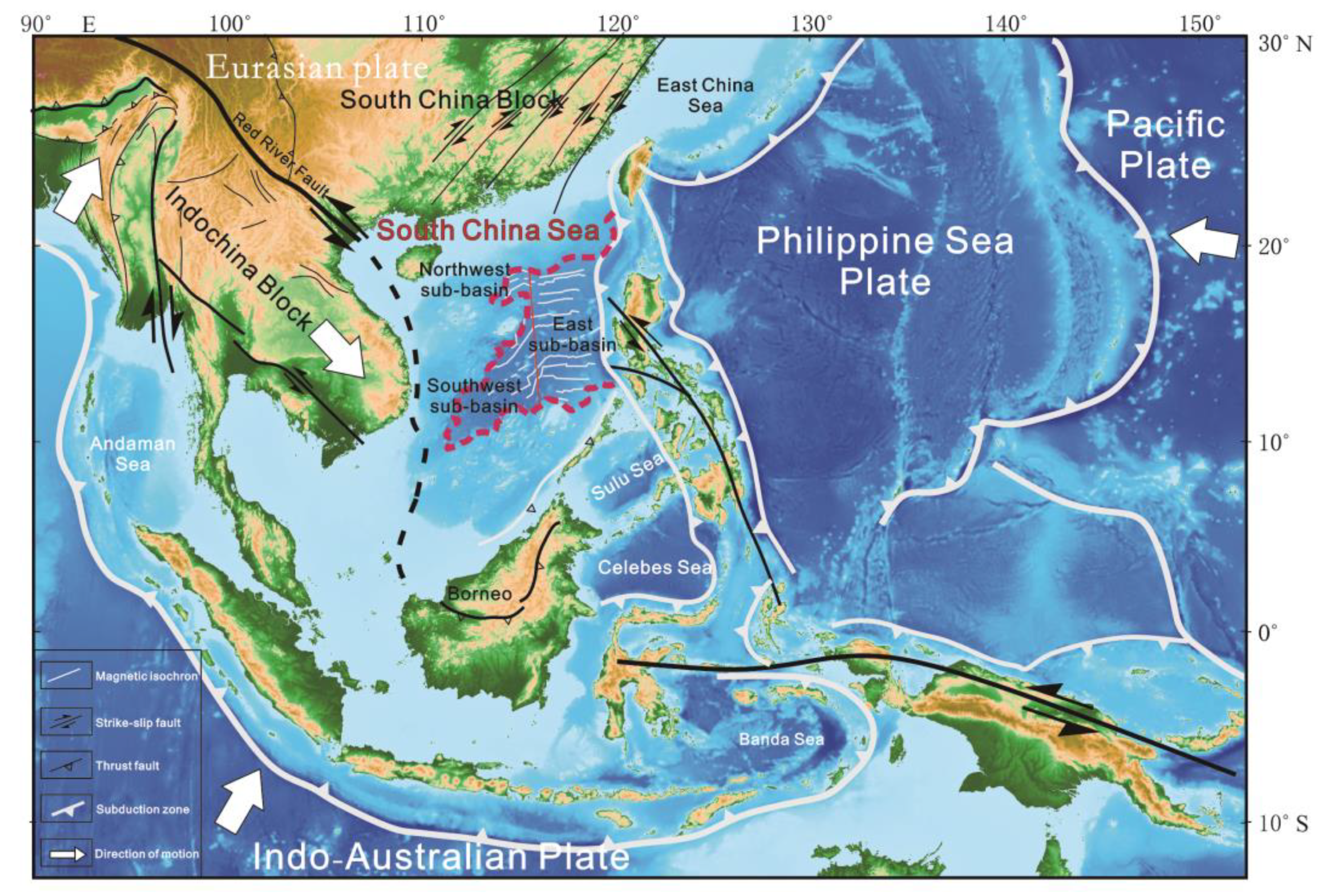
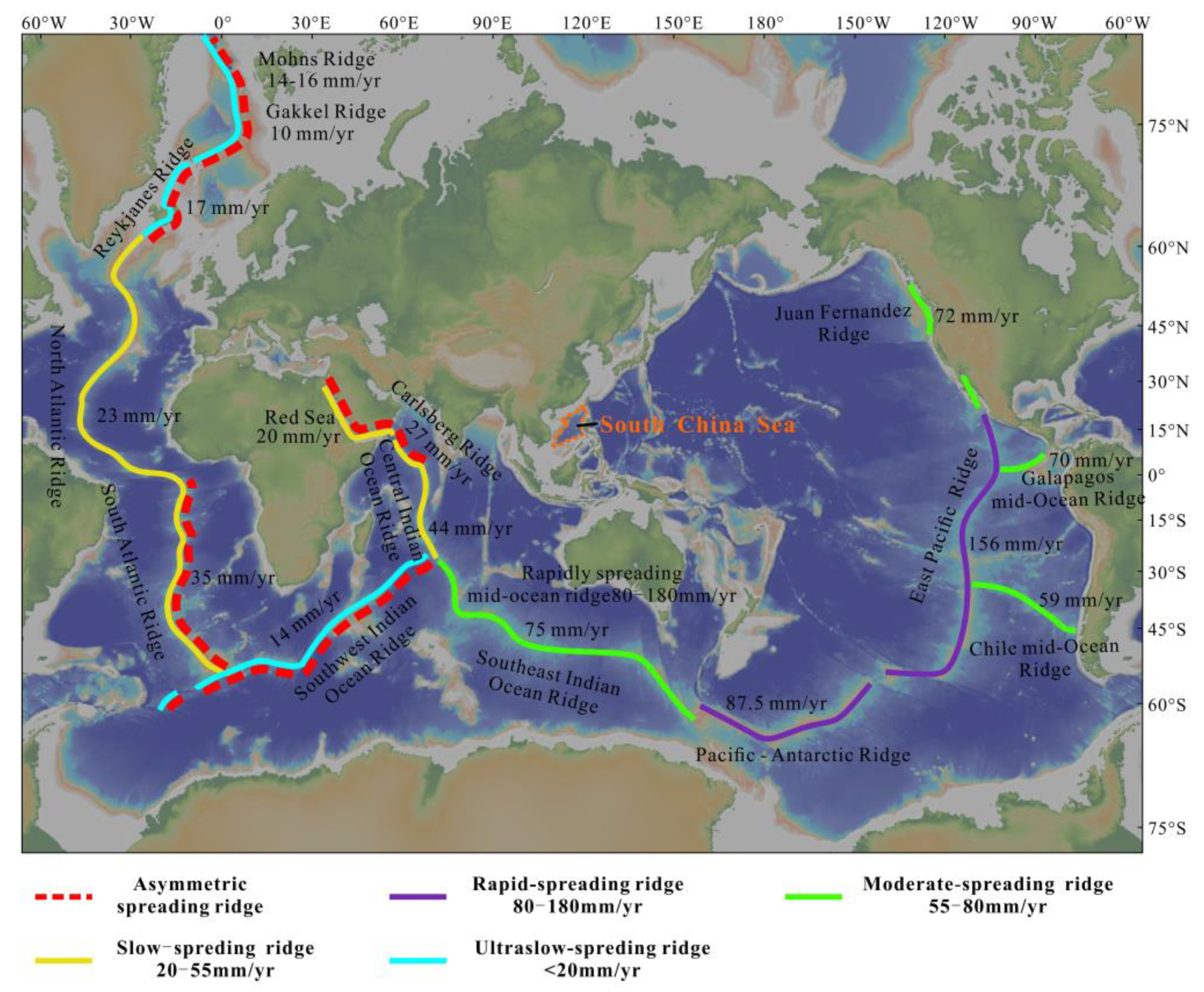
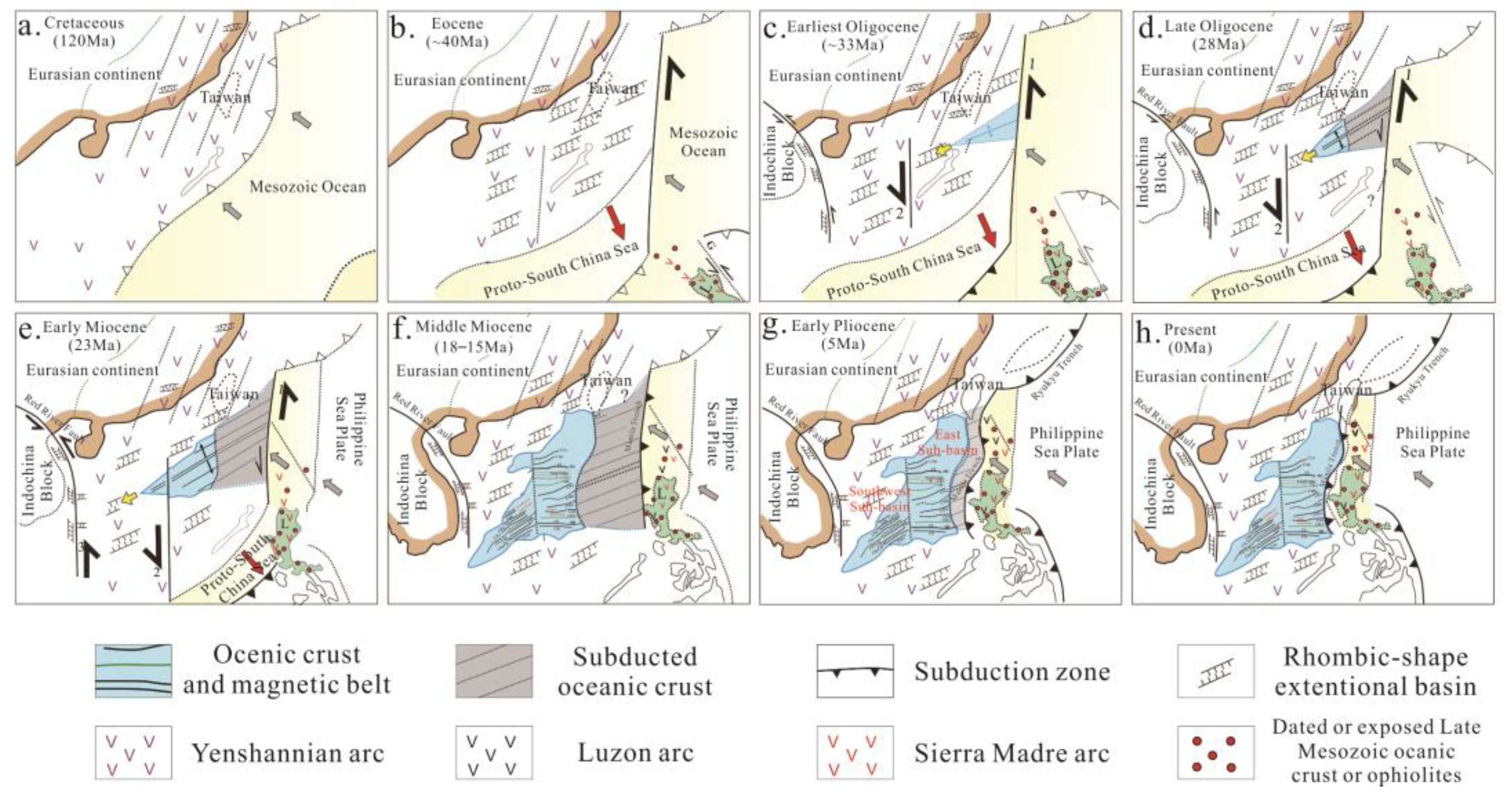

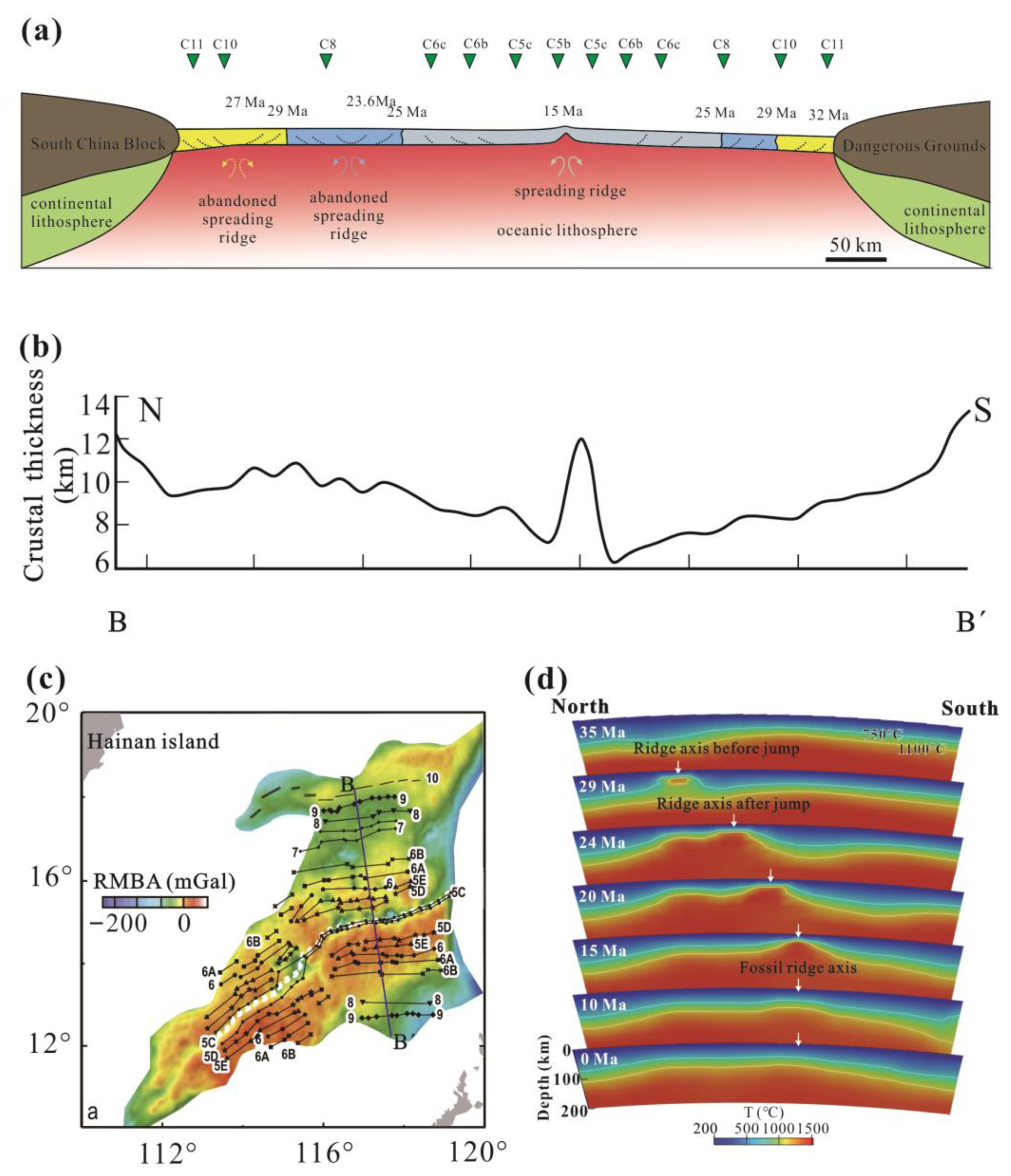
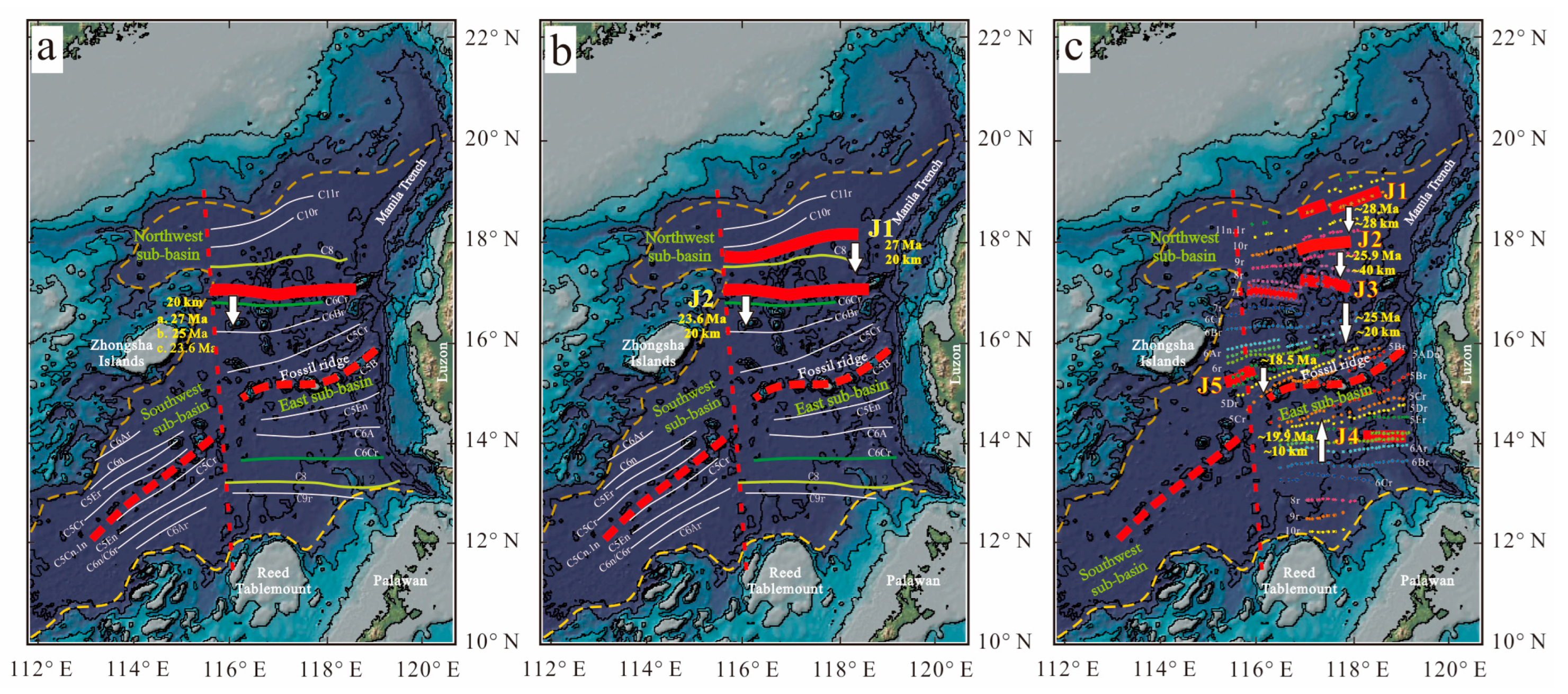
Disclaimer/Publisher’s Note: The statements, opinions and data contained in all publications are solely those of the individual author(s) and contributor(s) and not of MDPI and/or the editor(s). MDPI and/or the editor(s) disclaim responsibility for any injury to people or property resulting from any ideas, methods, instructions or products referred to in the content. |
© 2024 by the authors. Licensee MDPI, Basel, Switzerland. This article is an open access article distributed under the terms and conditions of the Creative Commons Attribution (CC BY) license (https://creativecommons.org/licenses/by/4.0/).
Share and Cite
Wei, J.; Dai, S.; Cheng, H.; Wang, H.; Wang, P.; Li, F.; Xie, Z.; Zhu, R. Review of Asymmetric Seafloor Spreading and Oceanic Ridge Jumps in the South China Sea. J. Mar. Sci. Eng. 2024, 12, 408. https://doi.org/10.3390/jmse12030408
Wei J, Dai S, Cheng H, Wang H, Wang P, Li F, Xie Z, Zhu R. Review of Asymmetric Seafloor Spreading and Oceanic Ridge Jumps in the South China Sea. Journal of Marine Science and Engineering. 2024; 12(3):408. https://doi.org/10.3390/jmse12030408
Chicago/Turabian StyleWei, Jiangong, Shuangling Dai, Huai Cheng, Houjin Wang, Pengcheng Wang, Fuyuan Li, Zhiyuan Xie, and Rongwei Zhu. 2024. "Review of Asymmetric Seafloor Spreading and Oceanic Ridge Jumps in the South China Sea" Journal of Marine Science and Engineering 12, no. 3: 408. https://doi.org/10.3390/jmse12030408
APA StyleWei, J., Dai, S., Cheng, H., Wang, H., Wang, P., Li, F., Xie, Z., & Zhu, R. (2024). Review of Asymmetric Seafloor Spreading and Oceanic Ridge Jumps in the South China Sea. Journal of Marine Science and Engineering, 12(3), 408. https://doi.org/10.3390/jmse12030408






